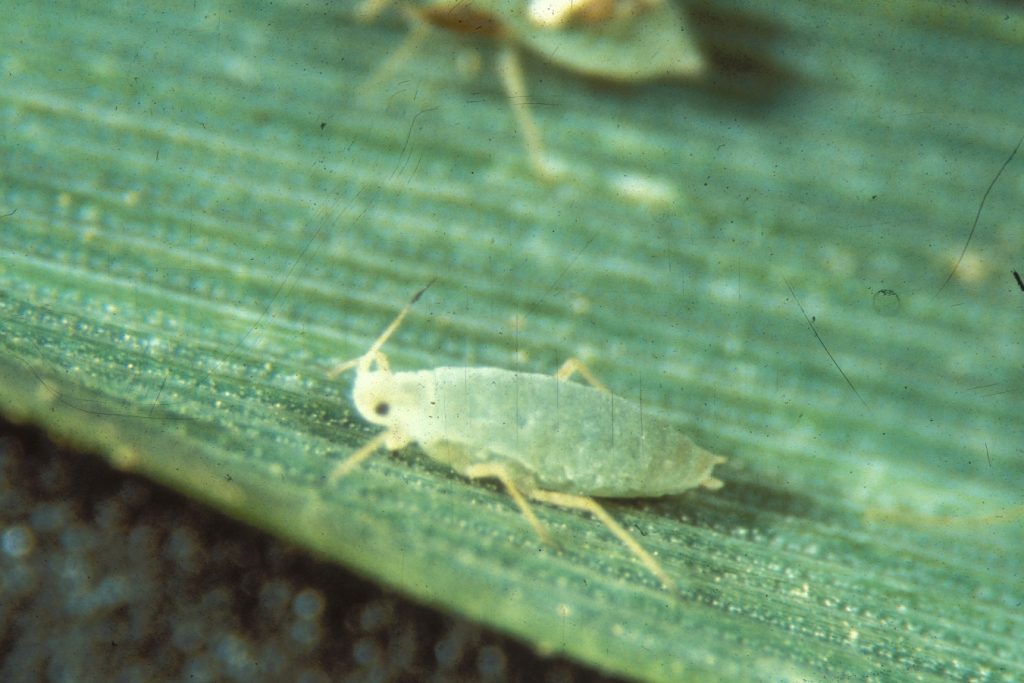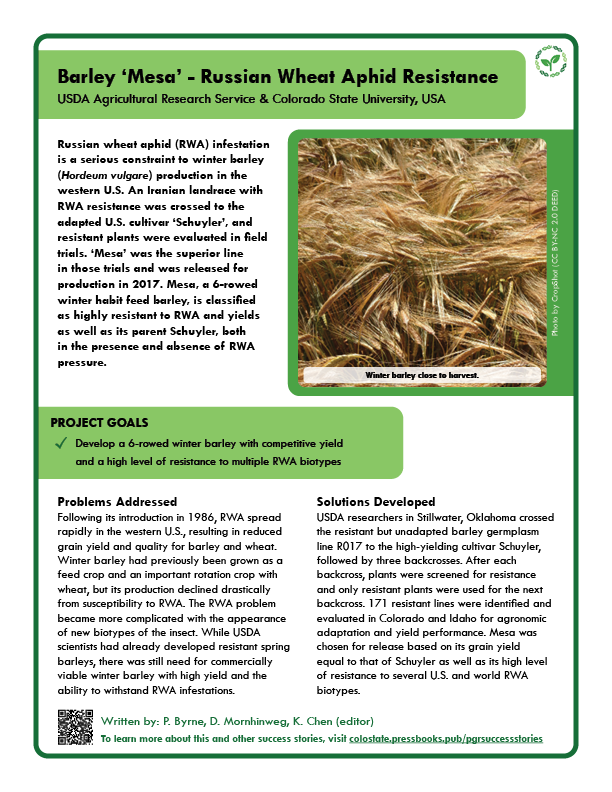Cereals and Pseudocereals
Barley ‘Mesa’ – Russian Wheat Aphid Resistance
DEVELOPMENT OF THE WINTER FEED BARLEY CULTIVAR ‘MESA’ (HORDEUM VULGARE) WITH RESISTANCE TO THE RUSSIAN WHEAT APHID
Patrick F. Byrne and Dolores W. Mornhinweg
Department of Soil and Crop Sciences, Colorado State University, 307 University Ave, Fort Collins, Colorado 80523.
USDA-ARS Peanut and Small Grains Research Unit, 1301 N Western Rd, Stillwater, Oklahoma 74075.
Corresponding author: patrick.byrne@colostate.edu
OUTLINE
1. SUMMARY

Russian wheat aphid (RWA, Diuraphis noxia (Kurdjumov)) infestation is a serious constraint to winter barley (Hordeum vulgare) production in the western U.S. An Iranian landrace with RWA resistance was crossed to the adapted U.S. cultivar ‘Schuyler’ (Jensen, 1972), followed by multiple backcrosses. Resistant plants were selected in Oklahoma and evaluated in field trials in Colorado and Idaho. ‘Mesa’ was the superior line in those trials and was released for production in 2017 (Mornhinweg et al., 2017). Mesa, a 6-rowed winter habit feed barley, is classified as highly resistant to RWA and yields as well as its parent Schuyler, both in the presence and absence of RWA pressure.
The goal was to develop a line of commercially viable winter barley that could withstand Russian wheat aphid infestations.
Download a printable fact sheet by clicking the image below.
2. PROBLEMS ADDRESSED

Following its introduction in 1986, RWA spread rapidly in the western U.S., resulting in reduced grain yield and quality (Mornhinweg et al., 2006). Winter barley had previously been grown as a feed crop and an important rotation crop with wheat (Triticum aestivum), but its production declined drastically due to susceptibility to RWA (Mornhinweg et al., 2017). All U.S. barley cultivars were susceptible to RWA. Four resistant feed cultivars were developed and released by USDA-ARS scientists in Stillwater, Oklahoma and Aberdeen, Idaho; however, they were 2-rowed spring habit barleys that filled a different cropping niche. The RWA problem became more complicated with the appearance of new biotypes of the insect; there are now at least eight recognized biotypes with differential virulence against barley and wheat varieties (Mornhinweg et al., 2017). Thus, a 6-rowed winter barley was needed with competitive yield and a high level of resistance to multiple RWA biotypes.
3. SOLUTIONS DEVELOPED

The resistant but unadapted barley germplasm line R017 from the National Plant Germplasm (NPGS) facility in Aberdeen, Idaho was crossed to the adapted cultivar Schuyler, followed by three backcrosses to the adapted parent. After each backcross, plants were screened for resistance and resistant plants were used for the next backcross (Webster et al., 1991). 171 resistant lines were identified and evaluated in Fruita, Colorado for agronomic adaptation and yield performance. Additional yield testing occurred in Idaho and in multistate trials (Mornhinweg et al., 2017). Mesa (PI 659768) was selected as the superior line based on its high level of resistance and grain yield equal to its parent Schuyler. It was developed and released by USDA-ARS researchers in Stillwater, Oklahoma.
Collaborators involved in developing solution:
- USDA-ARS Peanut and Small Grains Research Unit, Stillwater, Oklahoma, USA
- Colorado State University, Grand Junction, Colorado, USA
- USDA-ARS Small Grains and Potato Germplasm Research, Aberdeen, Idaho, USA
4. IMPACT
Mesa was the first RWA-resistant winter barley cultivar and yielded as well or better than Schuyler, either in the presence or absence of RWA pressure (Mornhinweg et al., 2017). It has Plant Variety Protection status, with certified seed available from the licensee (Mornhinweg et al., 2017).
5. GERMPLASM
Mesa is conserved by the NPGS as PI 659768 as a part of their Plant Variety Protection Voucher Collection. Small quantities of seed for breeding or research are available from do.mornhinweg@usda.gov. The pedigree of Mesa is Schuyler*4/R017.
R017 is unadapted germplasm selected by USDA-ARS researchers in Stillwater, Oklahoma from CI 10721. R017 is resistant to RWA U.S. biotypes 1 to 3, as well as to biotypes from Chile, Hungary, Iran, and Mexico (Dahleen et al., 2104; Mornhinweg et al., 2017).
Schuyler (CI 11887) is a hardy, 6-rowed winter feed barley developed at Cornell University and released in 1969 (Jensen, 1972).
6. REFERENCES
Dahleen LS, Mornhinweg D, Bregitzer P, Vitou J, Cakir M. 2014. Biotype differences for resistance to Russian wheat aphid in barley. Crop Science 54:1505-1513. https://doi.org/10.2135/cropsci2013.09.0616
Jensen NF. 1972. Registration of Schuyler barley. Crop Science 12:124. https://doi.org/10.2135/cropsci1972.0011183X001200010046x
Mornhinweg DW, Brewer MJ, Porter DR. 2006. Effect of Russian wheat aphid on yield and yield components of field grown susceptible and resistant spring barley. Crop Science 46:36-42. https://doi.org/10.2135/cropsci2004.0768
Mornhinweg DW, Hammon RW, Obert DE. 2017. Registration of ‘Mesa’ Russian Wheat Aphid-resistant winter feed barley. Journal of Plant Registrations 11:85-88. https://doi.org/10.3198/jpr2016.09.0050crc
Webster JA, Baker CA, Porter DR. 1991. Detection and mechanisms of Russian wheat aphid (Homoptera:Aphididae) resistance in barley. Journal of Economic Entomology 84:669-673. https://doi.org/10.1093/jee/84.2.669
7. CHAPTER INFORMATION
Citation: Byrne P, Mornhinweg D. 2024. Barley ‘Mesa’ – Russian Wheat Aphid Resistance. In: Volk GM, Chen K, Byrne P (Eds.) Plant Genetic Resources: Success Stories. Fort Collins, Colorado: Colorado State University. Date accessed. Available from https://colostate.pressbooks.pub/pgrsuccessstories/chapter/barley-mesa-russian-wheat-aphid-resistance/
Content originally submitted: January 17, 2024
Date of publication: May 20, 2024
USDA is an equal opportunity provider, employer, and lender. Mention of trade names or commercial products in this article is solely for the purpose of providing specific information and does not imply recommendation or endorsement by the U.S. Department of Agriculture.


